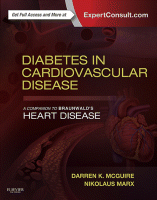Physical Address
304 North Cardinal St.
Dorchester Center, MA 02124

In the United States, the prevalence of high cholesterol, hypertension, and cigarette smoking together with age-adjusted cardiovascular deaths has declined over the last several decades. On the other hand, the prevalence of diabetes has risen steadily, largely because of an…

Type 1 diabetes (T1D) is an autoimmune disease that causes destruction of the pancreatic beta cells, leading to absolute insulin deficiency (see also Chapter 3 ). Type 2 diabetes (T2D), in contrast, is associated with obesity and is characterized by…

Overview The interaction between diabetes and atherosclerosis is complex and multifactorial. Despite unequivocal evidence for increased cardiovascular disease (CVD) risk in patients with diabetes; a well-documented epidemic of obesity and diabetes; intensive research efforts that include major preclinical scientific progress…

Diabetes and Accelerated Atherosclerosis Scope and Complexity of the Problem One of the most deadly complications of types 1 and 2 diabetes is accelerated atherosclerosis, the consequences of which include more frequent and more deadly heart attacks and strokes, as…

Diabetes mellitus is associated with the development of accelerated atherosclerotic coronary artery disease, which results in increased morbidity and mortality from cardiovascular complications including acute myocardial infarction and stroke. , Atherothrombosis is the leading cause of death worldwide despite major…

Prevalence of Impaired Glucose Metabolism in Patients with Manifest Atherosclerosis In patients with manifest coronary heart disease (CHD), based on the Ludwigshafen Risk and Cardiovascular Health (LURIC) study, approximately 20% of men and 25% of women had previously diagnosed diabetes.…

Detection of individuals at risk of future diseases and implementation of programs to reduce risk of progression to disease are fundamental objectives of reducing the burden of medical conditions such as diabetes. Prevention of diabetes also offers the opportunity to…

In recent decades the world has experienced a significant increase in the number of patients with diabetes mellitus, primarily type 2 diabetes mellitus (T2DM). Parallel to this, the increase is mostly attributable to a significantly higher frequency of diabetes diagnosis…

The metabolic syndrome (MetS) is defined as clustering of metabolic components that occur together more often than by chance alone and predispose to atherosclerotic vascular disease and diabetes. First descriptions of associated metabolic diseases occurred at the beginning of the…

Type 1 diabetes mellitus (T1DM) is one of the most prevalent chronic diseases of childhood, affecting more than 1.4 million people in the United States, of whom 150,000 are children. , Over the past 50 years, the incidence in children…